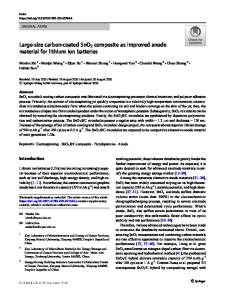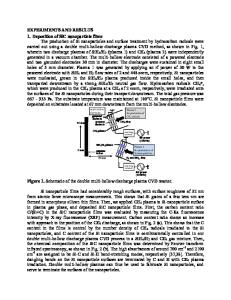Amorphous SiO 2 /C composite as anode material for lithium-ion batteries
- PDF / 549,684 Bytes
- 7 Pages / 584.957 x 782.986 pts Page_size
- 23 Downloads / 368 Views
Xiang Yu Instrumental Analysis & Research Center, Jinan University, Guangzhou, Guangdong 510632, China
Xiaoxian Wu, Bodong Zhang, and Yunfeng Zhan Siyuan Laboratory, Guangzhou Key Laboratory of Vacuum Coating Technologies and New Energy Materials, Guangdong Provincial Key Laboratory of Optical Fiber Sensing and Communications, Department of Physics, Jinan University, Guangzhou, Guangdong 510632, China
Fangyan Xie,a) Weihong Zhang, and Jian Chen Instrumental Analysis & Research Center, Sun Yat-sen University, Guangzhou, Guangdong 510275, China
Hui Mengb) Siyuan Laboratory, Guangzhou Key Laboratory of Vacuum Coating Technologies and New Energy Materials, Guangdong Provincial Key Laboratory of Optical Fiber Sensing and Communications, Department of Physics, Jinan University, Guangzhou, Guangdong 510632, China (Received 7 June 2017; accepted 29 June 2017)
This work designed a facile preparation for an SiO2/C composite as the anode material for lithium ion battery. Both SiO2 and carbon are amorphous. SiO2 and carbon are mixed uniformly. The SiO2/C composite shows high specific capacity, cycle stability, and rate capability in lithium ion battery charge–discharge test. A stable reversible capacity of 1024 mA h/g at the current density of 100 mA/g is reached. The capacity retains 83% after 100 cycles. The uniform mixture of SiO2 and carbon leads to reduced volume change during the lithiation and delithiation of SiO2, together with the amorphous nature of SiO2 explains the high cycling stability. The carbon coating is a key factor for the high capacity and stability due to the increased electrical conductivity and reduced volume change. The resistance of the solid electrolyte interface film and charge transfer resistance of the SiO2/C composite are much smaller than those of pure carbon, which is a direct proof of the improved conductivity of the material by the carbon coating.
I. INTRODUCTION
Lithium-ion batteries (LIBs) are widely used in portable electronic devices and electric vehicles. The market is demanding higher energy and powder density in LIBs, which is mainly determined by the materials used. It has been demonstrated to be an effective way to improve the capacity of LIBs by improving the performance of anode materials.1–5 Graphite is currently used as a common anode material in the industry, but the low theoretical capacity (372 mA h/g) limits the total capacity from further improving.6,7 Among the various anode materials studied, silicon (Si) is attractive due to its high theoretical specific capacity (4200 mA h/g).8 However, great volume Contributing Editor: Tianyu Liu Address all correspondence to these authors. a) e-mail: [email protected] b) e-mail: [email protected] c) These authors contributed equally to this work. DOI: 10.1557/jmr.2017.298
change (.300%) happens during the insertion/extraction of lithium ion (Li1), which will lead to the collapse of the anode material.9–13 So more attentions have been paid to SiO2, which has smaller theoretical specific capacity (1961 mA h/g) but the volume change
Data Loading...











